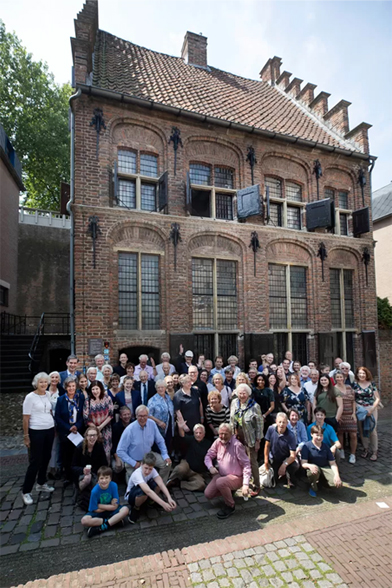Summary of articles from De Colve XI – 2006: Summary

From the Chairman (Van de Voorzitter)
The Chairman compares the first Kolff annual dinner party in 1920 at the home of Madeleine Kolff-Hanegraaff (great-grandmother of Marius) at Rotterdam with the current family reunions. This dinner party in 1920 was initiated by Constantijn (Tanny) and Herman (Herry), sons of the Kolff-Hanegraaffs, and had a very formal character (dressed suit and white tie). Most important feature was that only men were allowed to join. With the current reunions the family connection is continuously cherished which manifests itself by the use of the colourful Kolff ties and shawls by most of the participants. Recently discovered material contains pictures of the first and the following (1924) dinner party. The first party had 16 participants, while at the second dinner party this number had already grown to 32.
The recently discovered material will be added to the Family Kolff archive at the Municipal Archives in Rotterdam. Check the 40-pages long inventory of the Family Kolff archive by using the link from the Kolff website. The conservation of our cultural heritage by maintaining the Family Kolff archives, keeping the genealogy up-to-date, the organisation of family reunions, and maintaining the website are the foundations of our Family Association. If you have anything you of which think it should be kept in the Family Kolff archives please contact the Archivist.
Many changes have taken place in the 80 years of our Association and even more since the birth of our ancestor Henric Colve, now approximately 660 years ago. The Chairman points out that most profound changes may have been those of around the recent millennium change.
From the Editors (Van de Redactie)
A short introduction the this issue of De Colve: a view into the matters of the Kolff Family, in the present and the past, about close and sometimes distant relatives, from the Netherlands and abroad. Each author contributes in his or her own way. From any given Family Day to the closing date of De Colve items are sent it on request or at the author’s own initiative. For the authors there is the thankful job to create, with this material, this one and only De Colve XI.
Amstelveen in the Time of War (Amstelveen in Oorlogstijd), by Robert Kolff
In this article Robert describes his experiences as a child in war time Amstelveen. He was still a child when he and his family moved to Amstelveen in 1939. His father, an officer in the Dutch Navy, flew to England in 1940 to continue the battle against the enemy, never to return home again. The message that reached the family about his father’s death, the Red Cross in a telegram: “missed believe killed”. Robert describes his experiences as a child in the time of the occupation of the Netherlands. The struggle for food in the winter of 1944. Food droppings in April 1945. The family moved to The Hague in 1946. Robert and his family settled in 1976 back in Amstelveen and continues living there. His father’s name is inserted at the Monument for the victims of World War II at the Broersepark in Amstelveen.
Willem Kolff Stichting (Foundation), by Herman Broers
The works of Willem Kolff find true recognition in the Netherlands in recent years after several years of ‘silence’. Willem Kolff is the inventor of the artificial kidney and has an outstanding academic career in the field of the development of artificial organs. He has recently been elected as the Greatest Overijsselaar (Overijssel is a province in the Netherlands). The founding of the Kolff Institute in 1996 has been the initial engine to promote, once again, his great works in the Netherlands. In 2003 the Institute changed to the Willem Kolff Foundation. This institute promotes innovations in the field of health care. The Kolff Museum at Kampen has been erected by the institute. The Kolff Family Association has donated a large sum to renovate the Willem Kolff chamber at this Museum. For more information on Willem Kolff, please check the link from the Kolff website or visit the Willem Kolff Stichting at: www.willemkolffstichting.nl (site not working properly: no link made).
Kolffs in the Tielerwaard, by Liesbeth Huijssoon-Kolff
At Deil in the Tielerwaard (Province of Gelderland) Kolff’s have settled since 1775. It is said that Georgius Justinus, born at Spijk, moved there after an affair with a domestic… Another reason could have been that he moved there because he met Johanna van Everdingen from Deil with whom he fell in love. With Johanna he had a son and a daughter. Again something happened why he had to move away and he did: he went to the West Indies. His eldest son, Gualtherus, did well in life and was the first in line of six Kolff’s to be subsequent burgomasters of Deil. The article of Liesbeth continues describing the whereabouts of these six Kolff burgomasters, of which some also held other prominent positions in Deil and in the province of Gelderland. She describes family life of the Kolff’s and writes about her own memories of which one of the saddest must have been the capture of her father, in 1942, by the German authorities. Her father was taken to a concentration camp where he died. In 1978 Deil was incorporated within a larger body combining four municipalities. This marked the end of a long line – since 1811 – of Kolff burgomasters at that town. Liesbeth ends her contribution with the question whether the young Kolff men were really always so happy with the matter of course to become a burgomaster. She concludes that it must have been since tradition was held up high in Deil and the Tielerwaard. (see Biographies: Deil)
Drie schippers op de Waal, by Dirk Kolff, archivist
Article is available in full at: History: Geography: Three skippers on the river Waal
Summary by: Marius Kolff (CBCD XVIIw4), secretary of the Kolff Family Association